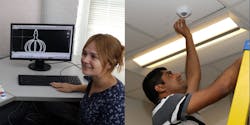Research linking networked SSL and 3D printing underway at the RPI Lighting Research Center
Scientists from the Lighting Research Center (LRC) at Rensselaer Polytechnic Institute (Troy, NY) are planning to install LED lighting with fixture-integrated and network-connected lighting controls in a 25,000 sq ft commercial office on the Rensselaer Technology Park campus. Among other goals, the team is examining how materials can be customized with additive manufacturing to have directional thermal conduction properties that allow for the production of custom solid-state lighting (SSL) fixtures.
The lighting controls are being tested to compare and quantify the additional benefits that connected lighting systems offer to users.The researchers will investigate everything from ease of installation to user satisfaction as part of their effort to support the SSL industry through research on the value of lighting beyond energy savings. Their efforts will be in the areas of lighting systems and components research, data analytics, field demonstration and market transformation activities, education, and industry collaboration.
“The idea is to avoid the commoditization of solid-state lighting by asking how we can use lighting for more than just illumination,” said Nadarajah Narendran, the LRC’s director of research and head of the SSL Program. “LED fixtures and lamps have mostly matured, so now there is a push toward exploring how LED lighting can be customized and how to use lighting to gather information that provides greater value to both producers and users.”
One value of 3D printing for SSL is the ability to design custom lighting fixtures that match the architectural features of a building and then manufacture them onsite. Narendran noted, “Last summer, one of our interns experimented with 3D printing of decorative OLED fixtures, where she created modular fixture templates that attached to an OLED panel and could be swapped out easily. Each template provides a different aesthetic look to the OLED fixture, giving homeowners or decorators the flexibility to change the look of a space as easily as moving furniture.”
3D printing also can be beneficially utilized at the fixture component level. LED lighting typically requires heat sinks to draw heat away to maintain life and light output. With 3D printing of fixtures, heat sinks can be designed to be part of the fixture envelope rather than attached afterwards, which would reduce the fixture’s bulk size and cost and improve its visual appeal.
Source: Lighting Research Center
